Study of ‘Cona degli Ordini’ by Colantonio with IR and XRF Analyses
Abstract
:1. Introduction
2. Materials and Methods
2.1. Materials
2.2. Methods
2.2.1. Infrared Reflectography (IR)
2.2.2. X-ray Fluorescence (XRF) and Scanning Macro-X-ray Fluorescence (MA-XRF)
3. Results and Discussion
3.1. IR Analysis
3.2. XRF and MA-XRF Analysis
4. Conclusions
Supplementary Materials
Author Contributions
Funding
Data Availability Statement
Acknowledgments
Conflicts of Interest
References
- Nicolini, F.; Summonte, P.; Michiel, M. L’arte napoletana del Rinascimento. In Napoli Nobilissima; Arte tipografica: Napoli, Italy, 1923; Volume 3, pp. 42–59, 68–79, 98–105, 121–146, 159–170. [Google Scholar]
- De Rinaldis, A. Pinacoteca del Museo Nazionale di Napoli Catalogo di Aldo De Rinaldis; Nuova Edition; Richter: Napoli, Italy, 1928; pp. 73–76. [Google Scholar]
- Bologna, F. Il Maestro di San Giovanni da Capestrano. In Proporzioni; Sansoni: Firenze, Italy, 1950; Volume 3, pp. 86–98. [Google Scholar]
- Bologna, F. Napoli e le Rotte Mediterranee Della Pittura, da Alfonso il Magnanimo a Ferdinando il Cattolico; Società Napoletana di Storia Patria: Napoli, Italy, 1977; pp. 57–71. [Google Scholar]
- De Castris, P. Museo e Gallerie Nazionali di Capodimonte. Dipinti dal XIII al XVI secolo. In Le Collezioni Borboniche e Post-unitarie; Electa: Napoli, Italy, 1999; pp. 55–57. [Google Scholar]
- Bologna, F. Il Polittico di Colantonio a San Lorenzo; Electa: Napoli, Italy, 2001; pp. 1–48. [Google Scholar]
- Sottili, L.; Giuntini, L.; Mazzinghi, A.; Massi, M.; Carraresi, L.; Castelli, L.; Czelusniak, C.; Giambi, F.; Mandò, P.A.; Manetti, M.; et al. The Role of PIXE and XRF in Heritage Science: The INFN-CHNet LABEC Experience. Appl. Sci. 2022, 12, 6585. [Google Scholar] [CrossRef]
- Gonzalez, V.; Cotte, M.; Vanmeert, F.; de Nolf, W.; Janssens, K. X-ray Diffraction Mapping for Cultural Heritage Science: A Review of Experimental Configurations and Applications. Chem. A Eur. J. 2020, 26, 1703–1719. [Google Scholar] [CrossRef] [PubMed]
- Gabrieli, F.; Dooley, K.A.; Facini, M.; Delaney, J.K. Near-UV to mid-IR reflectance imaging spectroscopy of paintings on the macroscale. Sci. Adv. 2019, 5. [Google Scholar] [CrossRef] [PubMed]
- Brocchieri, J.; de Viguerie, L.; Sabbarese, C.; Boyer, M. Combination of noninvasive imaging techniques to characterize pigments in Buddhist thangka paintings. X-Ray Spectrom. 2021, 50, 320–331. [Google Scholar] [CrossRef]
- Rosi, F.; Burnstock, A.; Van den Berg, K.J.; Miliani, C.; Brunetti, B.G.; Sgamellotti, A. A non-invasive XRF study supported by multivariate statistical analysis and reflectance FTIR to assess the composition of modern painting materials. Spectrochim. Acta Part A Mol. Biomol. Spectrosc. 2009, 71, 1655–1662. [Google Scholar] [CrossRef]
- Miguel, C.; Bottura-Scardina, S.; Bottaini, C.; Valadas, S.; Candeias, A.; Bilou, F. The Power of Combining MA-XRF, Infrared Reflectography and Digital Microscopy to Unveil the Production of the 16th Century Illuminated Charter of Évora: What May Be Hidden under a Painted Surface? Heritage 2022, 5, 286–296. [Google Scholar] [CrossRef]
- Falco, C.M. Invited Article: High resolution digital camera for infrared reflectography. Rev. Sci. Instrum. 2009, 80, 071301. [Google Scholar] [CrossRef]
- Daffara, C.; Fontana, R. Multispectral infrared reflectography to differentiate features in paintings. Microsc. Microanal. 2011, 17, 691–695. [Google Scholar] [CrossRef]
- Triolo, P.A.M. Manuale Pratico di Documentazione e Diagnostica per Immagine per i BB. CC.; Il Prato: Saonara, Italy, 2019. [Google Scholar]
- Bellaria, M.; Bertani, D. La riflettografia infrarossa. In I Trattati di Tecniche Artistiche Medievali; CUSL: Milano, Italy, 2006; pp. 115–137. [Google Scholar]
- Cardinali, M.; De Ruggieri, M.B.; Falcucci, C. Diagnostica Artistica. Tracce Materiali per la Storia Dell’arte e per la Conservazione; Palombi Editori: Roma, Italy, 2007; pp. 120–135. [Google Scholar]
- Alfeld, M.; De Viguerie, L. Recent developments in spectroscopic imaging techniques for historical paintings-a review. Spectrochim. Acta Part B At. Spectrosc. 2017, 136, 81–105. [Google Scholar] [CrossRef]
- Musílek, L.; Čechák, T.; Trojek, T. X-ray fluorescence in investigations of cultural relics and archaeological finds. Appl. Radiat. Isot. 2012, 70, 1193–1202. [Google Scholar] [CrossRef]
- Dos Santos, H.C.; Caliri, C.; Pappalardo, L.; Catalano, R.; Orlando, A.; Rizzo, F.; Romano, F.P. Real-time MA-XRF imaging spectroscopy of the Virgin with the Child painted by Antonello de Saliba in 1497. Microchem. J. 2018, 140, 96–104. [Google Scholar] [CrossRef]
- Trojek, T.; Trojkova, D. Several approaches to the investigation of paintings with the use of portable X-ray fluorescence analysis. Radiat. Phys. Chem. 2015, 116, 321–325. [Google Scholar] [CrossRef]
- Campanella, B.; Grifoni, E.; Hidalgo, M.; Legnaioli, S.; Lorenzetti, G.; Pagnotta, S.; Poggialini, F.; Ripoll-Seguer, L.; Palleschi, V. Multi-technique characterization of madder lakes: A comparison between non-and micro-destructive methods. J. Cult. Herit. 2018, 33, 208–212. [Google Scholar] [CrossRef]
- Sitko, R.; Zawisza, B. Quantification in X-ray fluorescence spectrometry. In X-Ray Spectroscopy; IntechOpen: London, UK, 2012; pp. 137–162. [Google Scholar] [CrossRef]
- Brocchieri, J.; Scialla, E.; Manzone, A.; Graziano, G.O.; Sabbarese, C. Gouache gilding on lead and wood objects studied by multivariate and graph analyses applied to XRF spectra. J. Archaeol. Sci. Rep. 2022, 42. [Google Scholar] [CrossRef]
- Marcaida, I.; Maguregui, M.; Fdez-Ortiz de Vallejuelo, S.; Morillas, H.; Prieto-Taboada, N.; Veneranda, M.; Castro, K.; Madariaga, J.M. In situ X-ray fluorescence-based method to differentiate among red ochre pigments and yellow ochre pigments thermally transformed to red pigments of wall paintings from Pompeii. Anal. Bioanal. Chem. 2017, 409. [Google Scholar] [CrossRef]
- De Castris, P.L. La riscoperta di Colantonio. Confronto 2019, 2, 42–65. [Google Scholar]
- Museo e Real Bosco di Capodimonte. Available online: https://capodimonte.cultura.gov.it (accessed on 27 December 2022).
- Opus Instruments. Available online: www.opusinstruments.com (accessed on 27 December 2022).
- Brocchieri, J.; Scialla, E.; Manzone, A.; Graziano, G.O.; D’Onofrio, A.; Sabbarese, C. An analytical characterization of different gilding techniques on artworks from the Royal Palace (Caserta, Italy). J. Cult. Herit. 2022, 57, 213–225. [Google Scholar] [CrossRef]
- Likas, A.; Vlassis, N.; Verbeek, J.J. The global k-means clustering algorithm. Pattern Recognit. 2003, 36, 451–461. [Google Scholar] [CrossRef]
- Solé, V.A.; Papillon, E.; Cotte, M.; Walter, P.; Susini, J. A multiplatform code for the analysis of energy-dispersive X-ray fluorescence spectra. Spectrochim. Acta Part B At. Spectrosc. 2007, 62, 63–68. [Google Scholar] [CrossRef]
- Sinisgalli, R. Il nuovo De pictura di Leon Battista Alberti; Kappa: Roma, Italy, 2006. [Google Scholar]
- Sinisgalli, R. Piero della Francesca. In De Prospectiva Pingendi; Silvana Editoriale: Cinisello Balsamo, Italy, 2021. [Google Scholar]
- Aceto, F. Spazio ecclesiale e pale di “primitivi” in San Lorenzo Maggiore a Napoli: Dal “San Ludovico” di Simone Martini al “San Girolamo” di Colantonio (II). In Prospettiva; Centro Di: Firenze, Italy, 2012; pp. 2–61. [Google Scholar]
- Bremenkamp, A. Ars Nova Translata: Altniederländische Malerei in Neapel und der Krone Aragon; Hirmer Verlag GmbH: Munich, Germany, 2021; pp. 157–225. [Google Scholar]
- Scialla, E.; Improda, P.; Brocchieri, J.; Cardinali, M.; Cerasuolo, A.; Rullo, A.; Zezza, A.; Sabbarese, C. Study of Colantonio’s paintings in the Capodimonte Museum using IR and XRF analyses. In Proceedings of the AIAr (Italian Association of Archaeometry) Thematic Conference entitled “Sustainability in Cultural Heritage”, Padua, Italy, 29 June–1 July 2022. [Google Scholar]
- Cardinali, M.; Improda, P.; Zezza, A.; Cerasuolo, A.; Rullo, A.; Brocchieri, J.; Sabbarese, C.; Scialla, E. La tecnica pittorica di Colantonio attraverso l’analisi del corpus di opere conservate a Capodimonte: Primi risultati e alcune riflessioni. Polygraphia 2022. submitted. [Google Scholar]
- Bellucci, R.; Bonanni, P.; Brunetti, B.G.; Calusi, S.; Castelli, C.; Ciatti, M.; Doherty, B.; Fontana, R.; Frosinini, C.; Giuntini, L.; et al. Il restauro del Ritratto Trivulzio di Antonello da Messina. OPD Restauro 2010, 22, 15–54. [Google Scholar]
- Larsen, R.; Coluzzi, N.; Cosentino, A. Free XRFSpectroscopy Database Of Pigments Checker. Int. J. Conserv. Sci. 2016, 7. [Google Scholar]
- Seccaroni, C.; Moioli, P.; Fluorescenza, X. Prontuario per L’analisi XRF Portatile Applicata A Superfici Policrome; Nardini: Firenze, Italy, 2002. [Google Scholar]
- Križnar, A.; Muñoz, M.D.V.; Paz, F.D.L.; Respaldiza, M.A.; Vega, M. Non-destructive XRF analysis of pigments in a 15th century panel painting 2008. In Proceedings of the 9th International Conference on NDT of Art 2008, Jerusalem, Israel, 25–30 May 2008. [Google Scholar]
- Van der Snickt, G.; Miliani, C.; Janssens, K.; Brunetti, B.G.; Romani, A.; Rosi, F.; Wittermann, R. Material analyses of ‘Christ with singing and music-making Angels’, a late 15th-C panel painting attributed to Hans Memling and assistants: Part, I. non-invasive in situ investigations. J. Anal. At. Spectrom. 2011, 26, 2216–2229. [Google Scholar] [CrossRef]
- Kirby, J.O. Marika Spring, Catherine Higgitt. The technology of red lake pigment manufacture: Study of the dyestuff substrate. Natl. Gallery Tech. Bull. 2005, 26, 71–87. [Google Scholar]
- Brunetti, B.G.; Seccaroni, C.; Sgamellotti, A. The Painting Technique of Pietro Vannucci Called Il Perugino: Proceedings of the LabS Tech Workshop; Nardini: Firenze, Italy, 2004; pp. 21–22. [Google Scholar]
- Lutzenberger, K.; Stege, H.; Tilenschi, C. A note on glass and silica in oil paintings from the 15th to the 17th century. J. Cult. Herit. 2010, 11, 365–372. [Google Scholar] [CrossRef]
- Dooley, K.A.; Conover, D.M.; Glinsman, L.D.; Delaney, J.K. Complementary standoff chemical imaging to map and identify artist materials in an early Italian Renaissance panel painting. Angew. Chem. 2014, 126, 13995–13999. [Google Scholar] [CrossRef]
- Roy, A. Artists’ Pigments: A Handbook of Their History and Characteristics; Archetype Publications: London, UK, 1993; Volume 2. [Google Scholar]
- Brocchieri, J.; Scialla, E.; Manzone, A.; Graziano, G.O.; D’Onofrio, A.; Sabbarese, C. The gilding technique on lead objects of the Royal Palace in Caserta (Italy) studied using XRF analysis. Mediterr. Archeol. Archeometry 2022, 22, 29–43. [Google Scholar]
- Alfeld, M.; Wahabzada, M.; Bauckhage, C.; Kersting, K.; Wellenreuther, G.; Falkenberg, G. Non-negative factor analysis supporting the interpretation of elemental distribution images acquired by XRF. J. Phys. Conf. Ser. 2014, 499. [Google Scholar] [CrossRef]
- Ricci, C.; Borgia, I.; Brunetti, B.G.; Miliani, C.; Sgamellotti, A.; Seccaroni, C.; Passalacqua, P. The Perugino’s palette: Integration of an extended in situ XRF study by Raman spectroscopy. J. Raman Spectrosc. 2004, 35, 616–621. [Google Scholar] [CrossRef]
- Leinwandmalerei, T.U. Mapping gold leaf in Gentile da Fabriano’s paintings: A case study. Burlingt. Mag. 2019, 161. [Google Scholar]
- A Non-Invasive Portable XRF Small Spot Mapping System for Cultural Heritage Studies and its Application. Available online: https://static1.squarespace.com/static/5de134ef5511bf790e2a9442/t/5e0df9ded2e3413f647bb408/1577974244339/precise+positioning+and+elio+mapping.pdf (accessed on 3 February 2023).
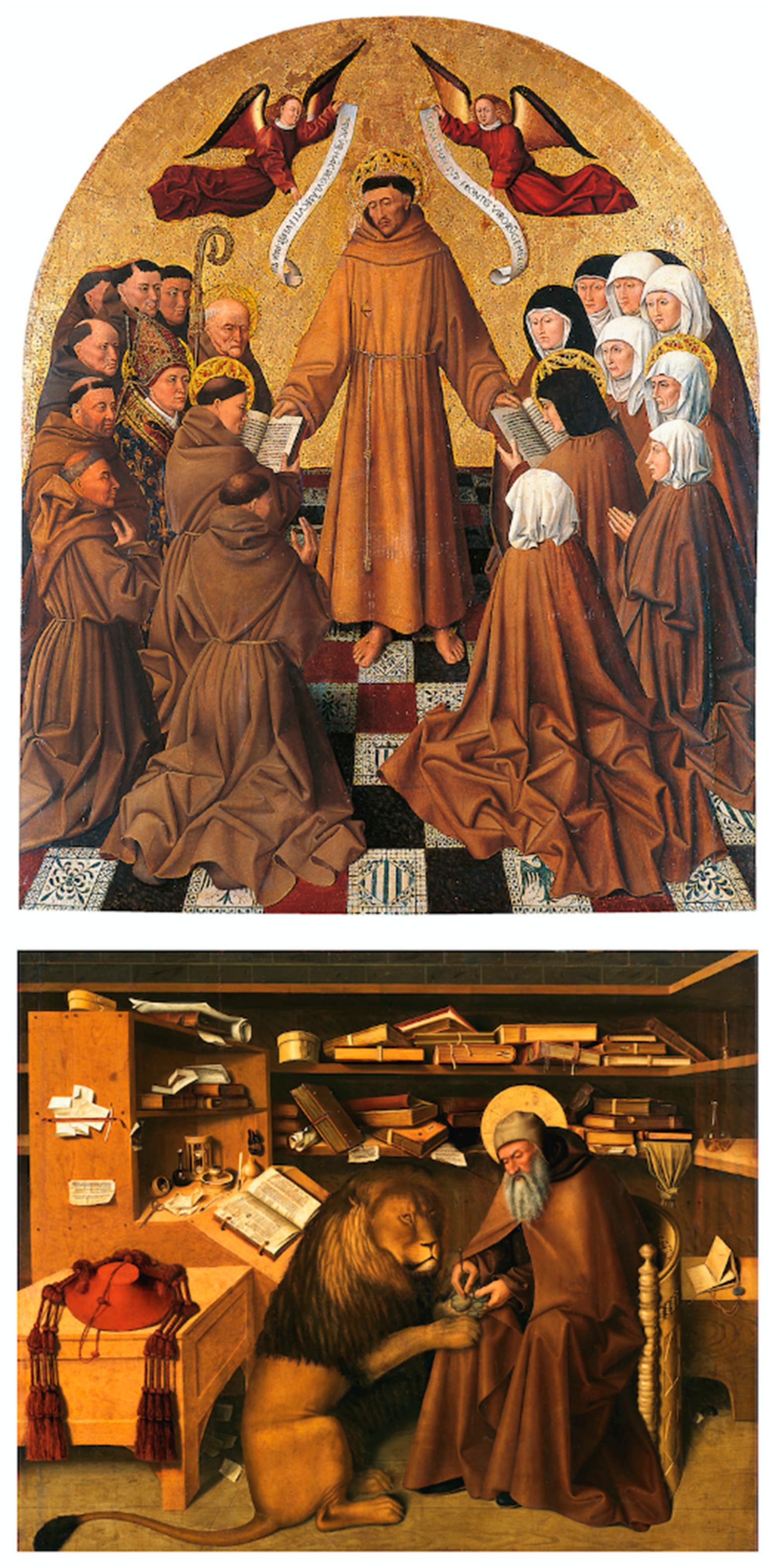


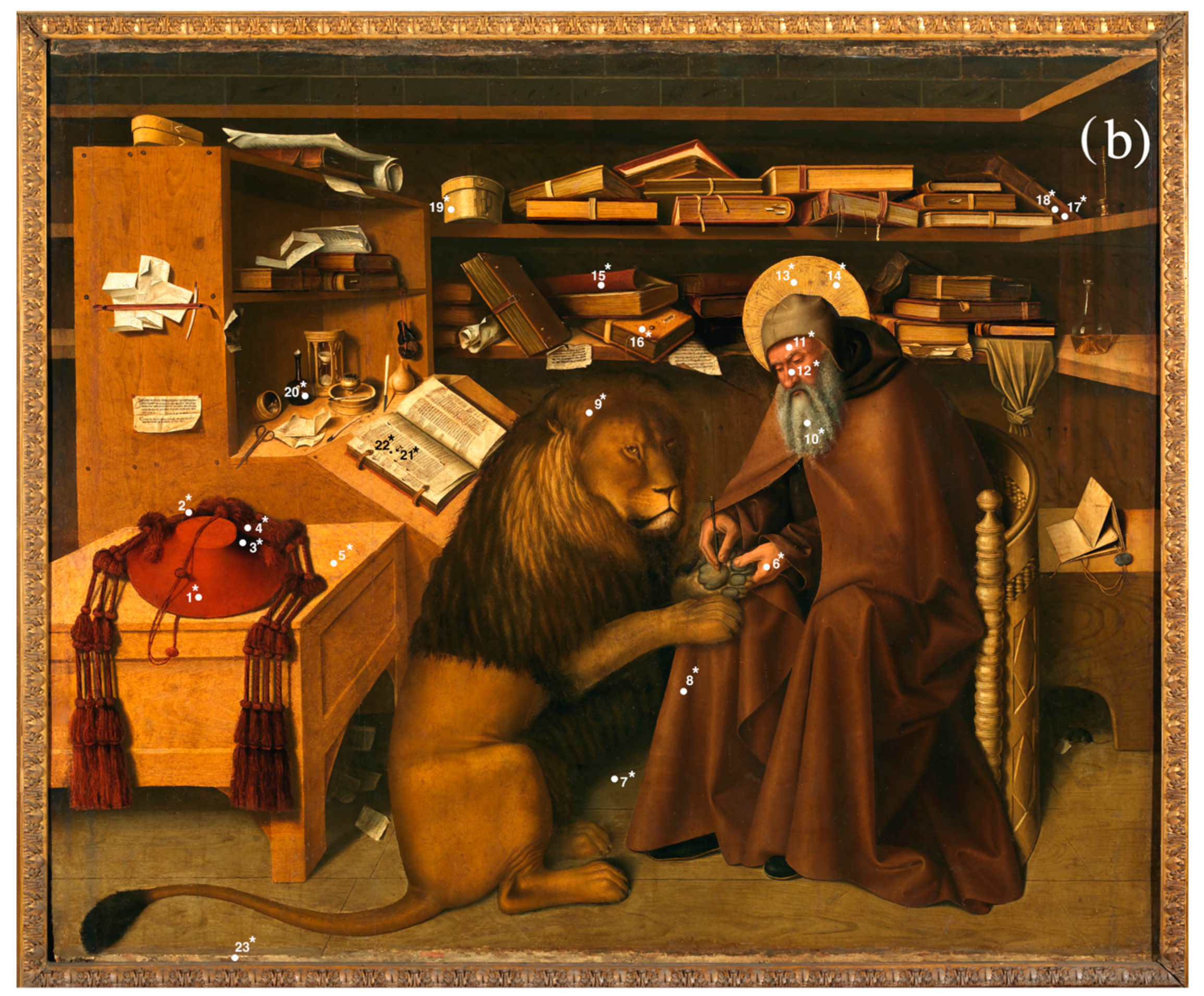



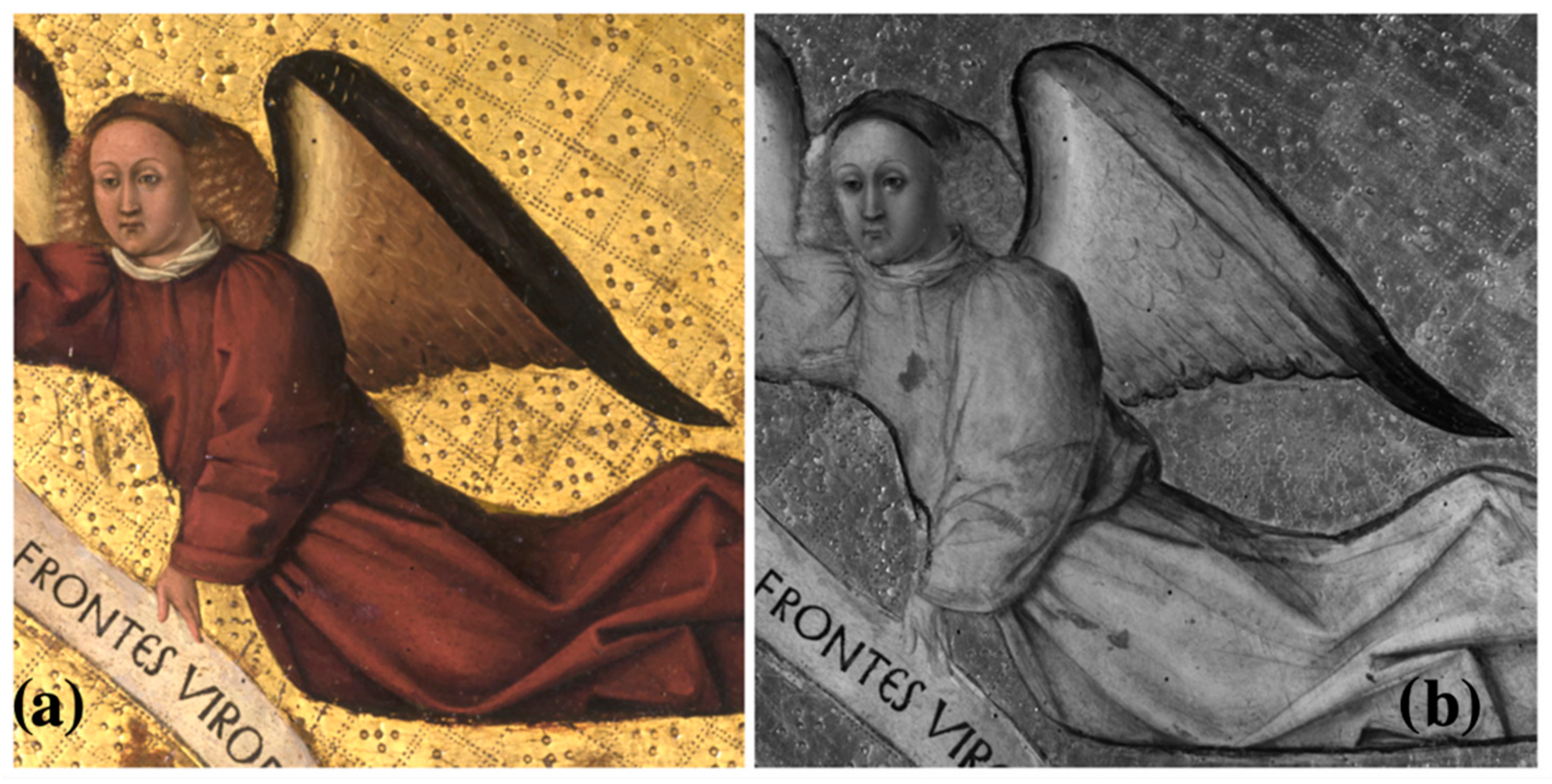
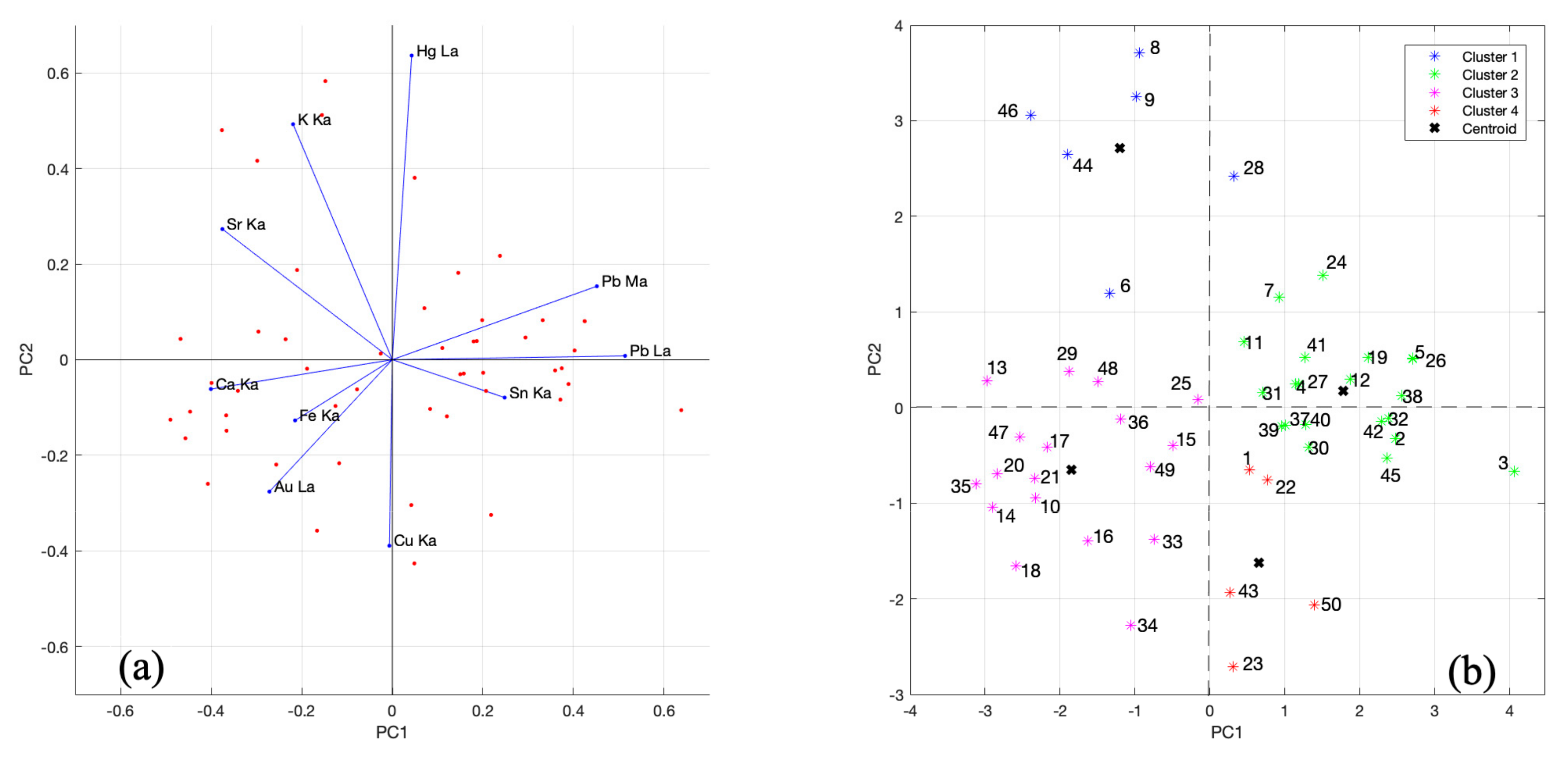
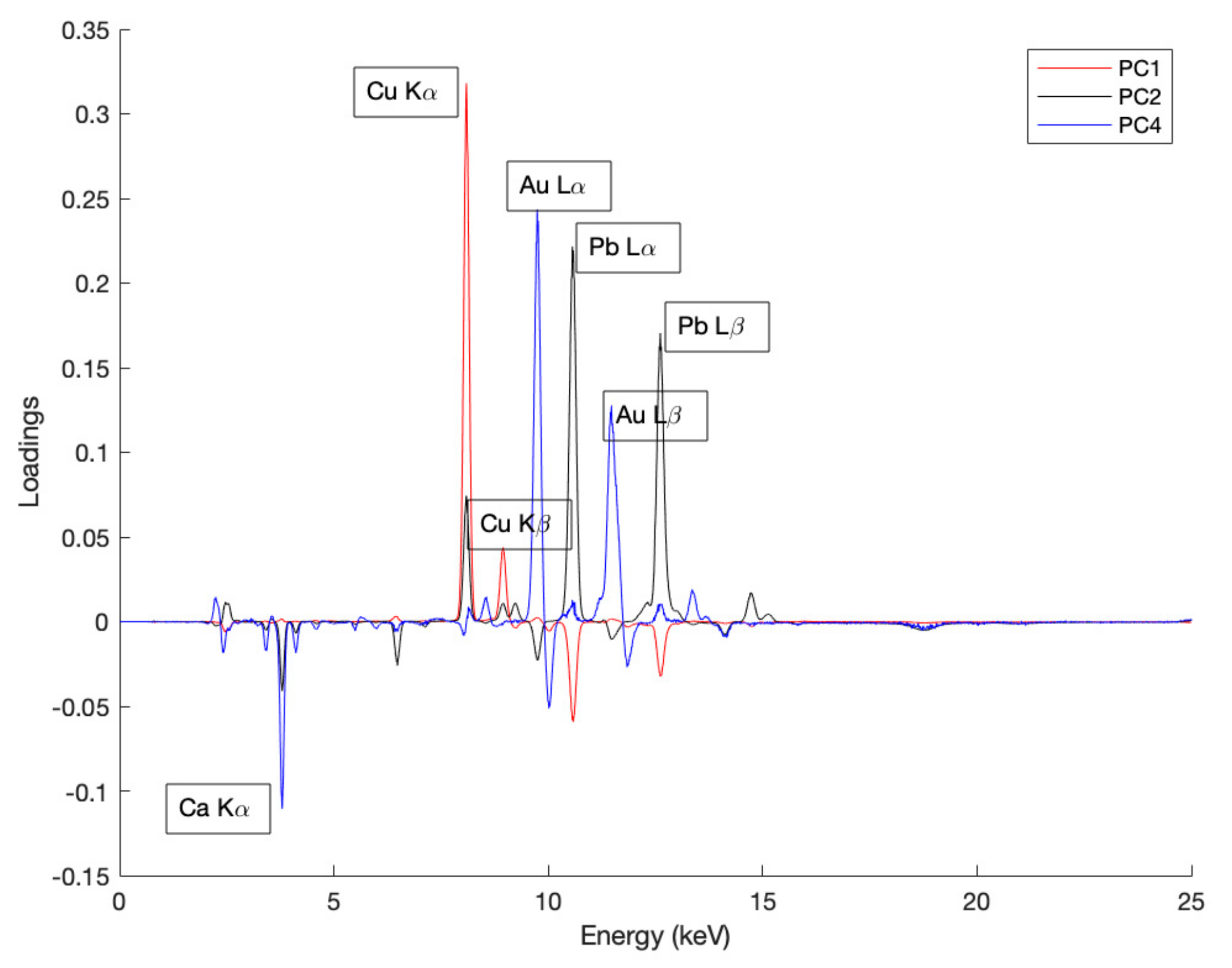
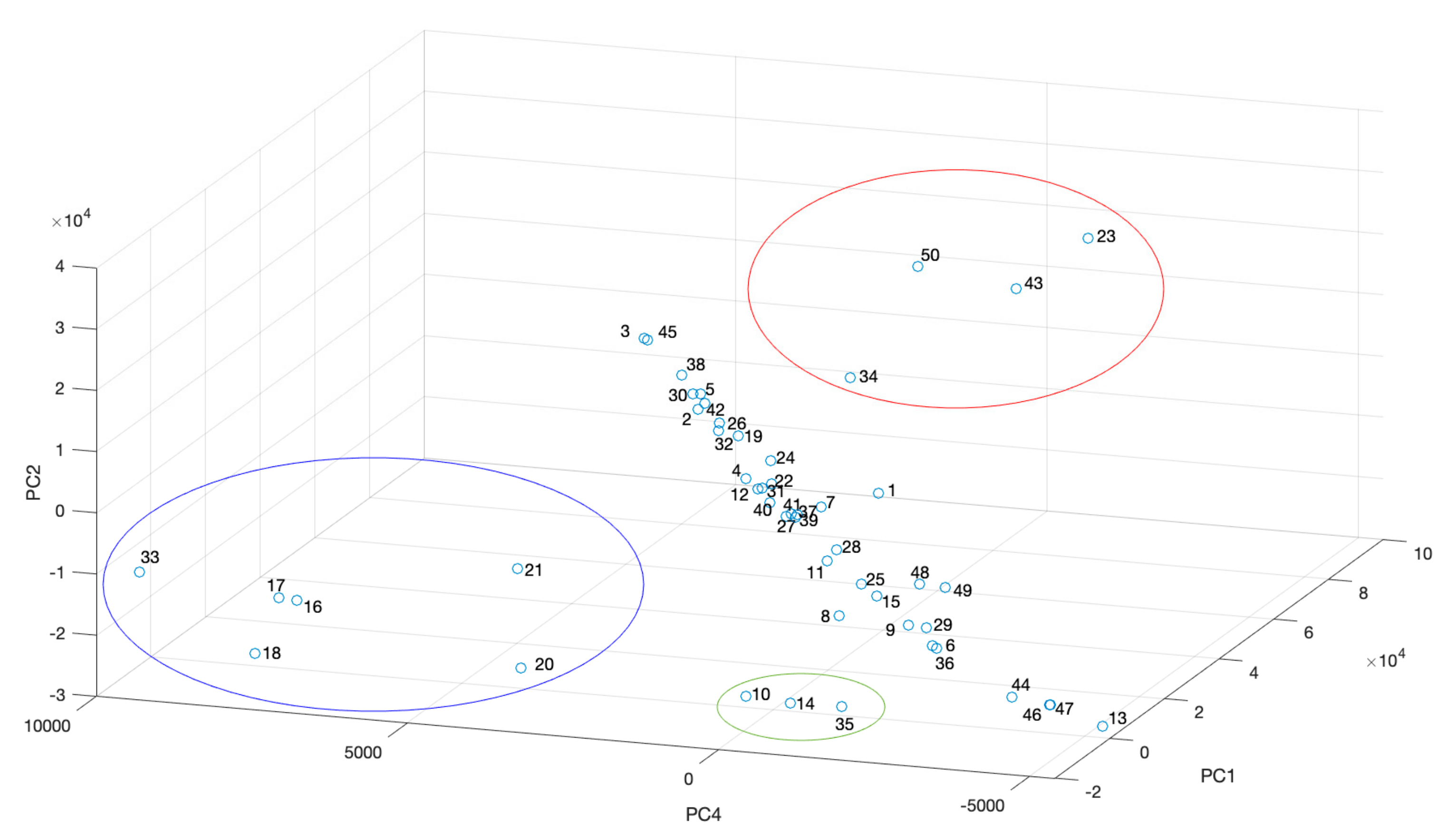
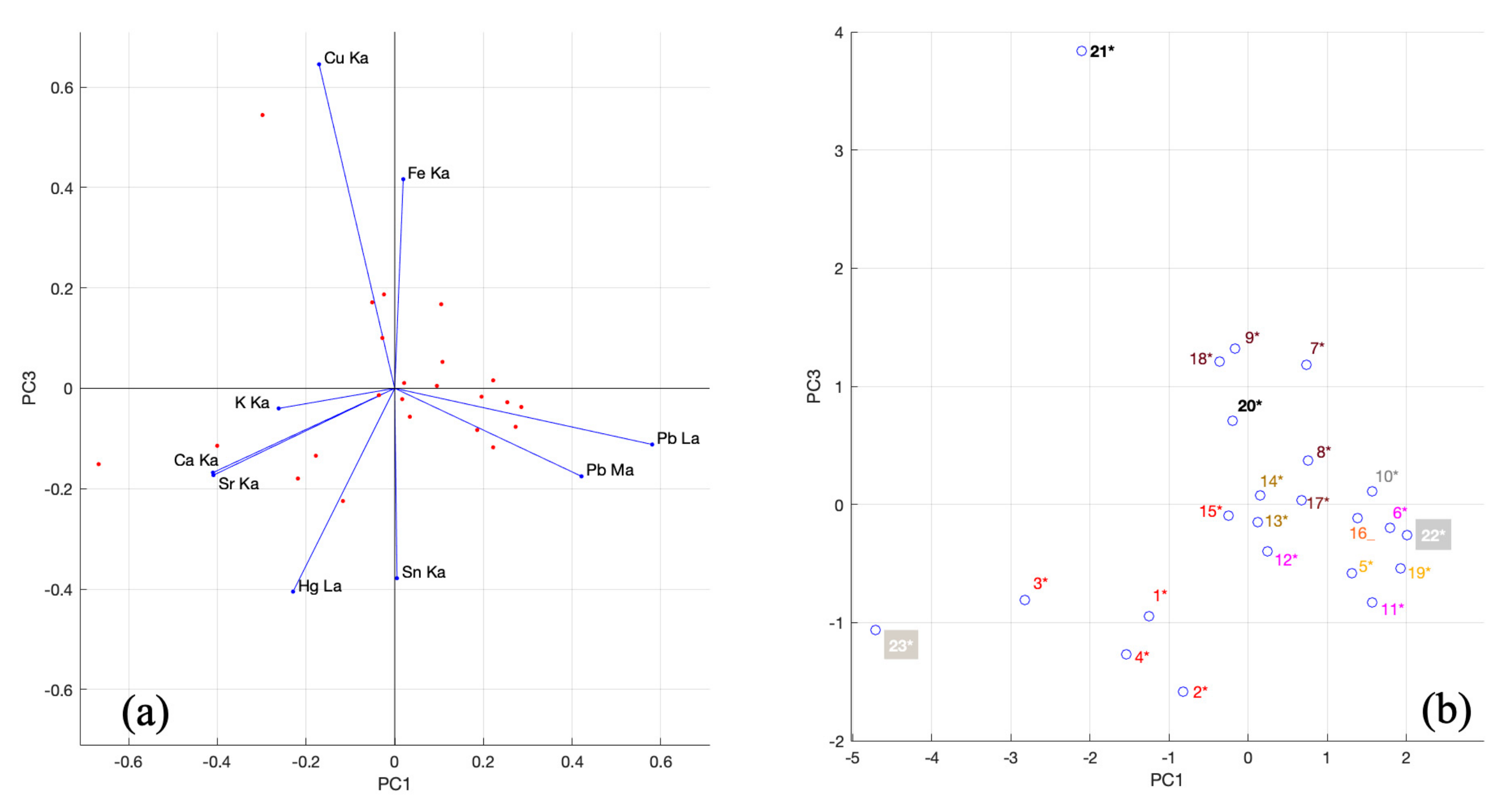
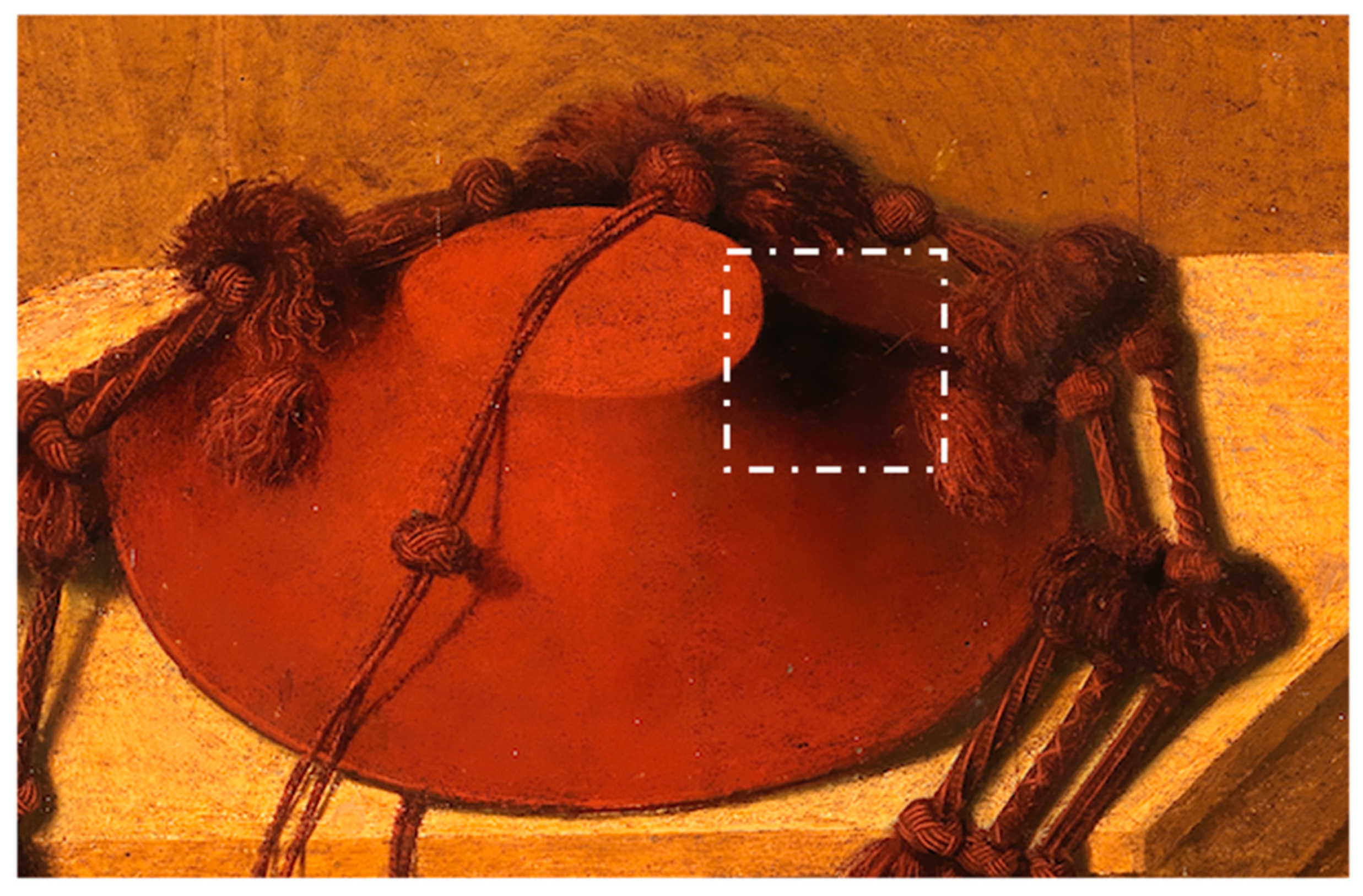
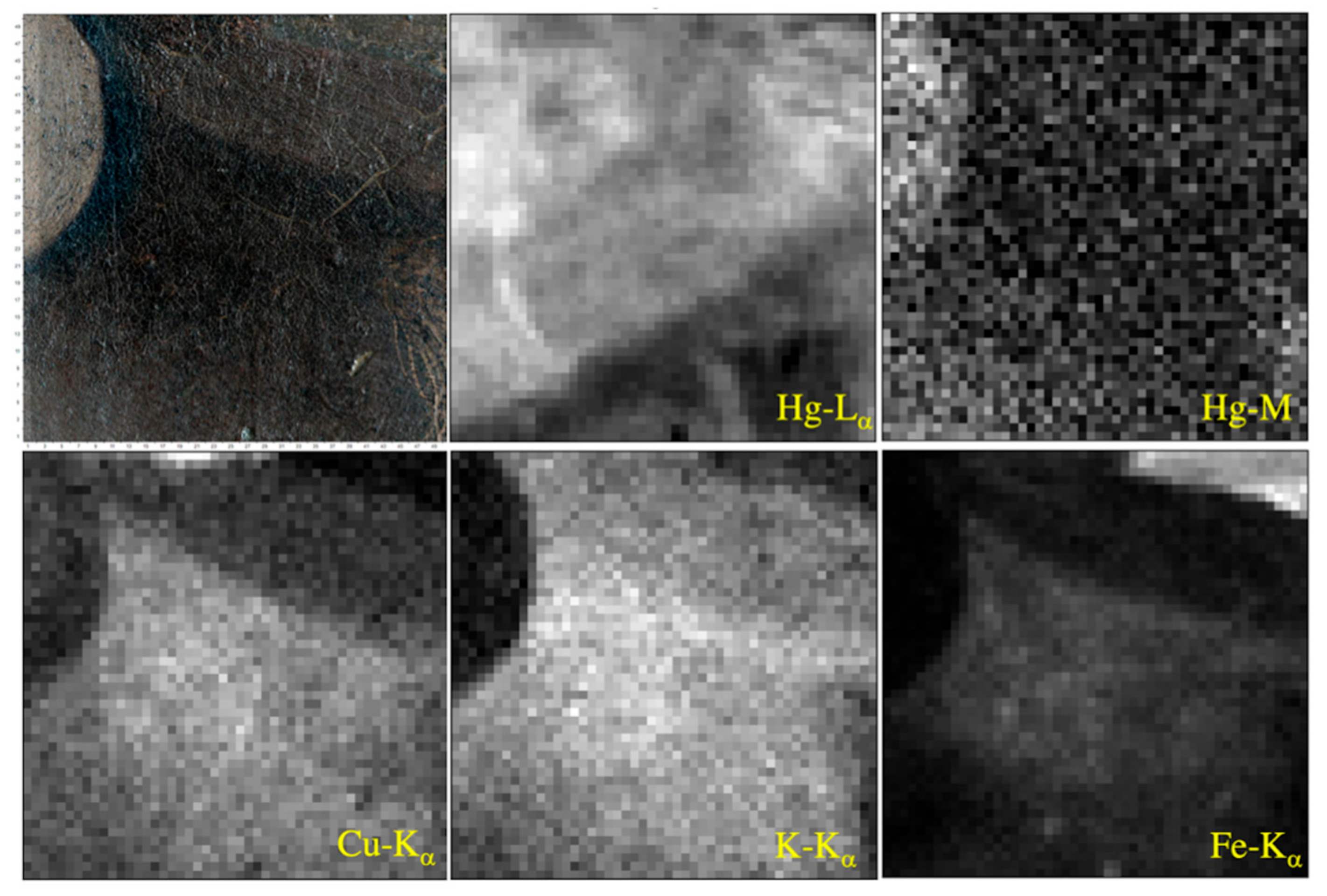
| Color | Use | Main Elements | Pigment |
|---|---|---|---|
| Red | Clothes, tile features, hats | Hg, K | Cinnabar, red lake |
| Pink | Skin tones | Hg, Pb, Sn | Cinnabar, lead white/minium, giallolino |
| yellow | Angel wings, furniture | Pb, Sn | Giallolino |
| Black | Saint Clare’s hat, ampulla, capital letter | Cu | Copper-based pigment |
| Light blue | tile features | Cu | Copper-based pigment |
| Brown | clothes | Hg, Fe | Cinnabar, iron-based pigment |
| Gold | Haloes, background of St. Francis | Au, Cu, Fe | Gold leaf, bolus, copper-based pigment |
| White | Book page, tile feature | Pb | Lead white |
Disclaimer/Publisher’s Note: The statements, opinions and data contained in all publications are solely those of the individual author(s) and contributor(s) and not of MDPI and/or the editor(s). MDPI and/or the editor(s) disclaim responsibility for any injury to people or property resulting from any ideas, methods, instructions or products referred to in the content. |
© 2023 by the authors. Licensee MDPI, Basel, Switzerland. This article is an open access article distributed under the terms and conditions of the Creative Commons Attribution (CC BY) license (https://creativecommons.org/licenses/by/4.0/).
Share and Cite
Scialla, E.; Improda, P.; Brocchieri, J.; Cardinali, M.; Cerasuolo, A.; Rullo, A.; Zezza, A.; Sabbarese, C. Study of ‘Cona degli Ordini’ by Colantonio with IR and XRF Analyses. Heritage 2023, 6, 1785-1803. https://doi.org/10.3390/heritage6020095
Scialla E, Improda P, Brocchieri J, Cardinali M, Cerasuolo A, Rullo A, Zezza A, Sabbarese C. Study of ‘Cona degli Ordini’ by Colantonio with IR and XRF Analyses. Heritage. 2023; 6(2):1785-1803. https://doi.org/10.3390/heritage6020095
Chicago/Turabian StyleScialla, Elvira, Paola Improda, Jessica Brocchieri, Marco Cardinali, Angela Cerasuolo, Alessandra Rullo, Andrea Zezza, and Carlo Sabbarese. 2023. "Study of ‘Cona degli Ordini’ by Colantonio with IR and XRF Analyses" Heritage 6, no. 2: 1785-1803. https://doi.org/10.3390/heritage6020095
APA StyleScialla, E., Improda, P., Brocchieri, J., Cardinali, M., Cerasuolo, A., Rullo, A., Zezza, A., & Sabbarese, C. (2023). Study of ‘Cona degli Ordini’ by Colantonio with IR and XRF Analyses. Heritage, 6(2), 1785-1803. https://doi.org/10.3390/heritage6020095











